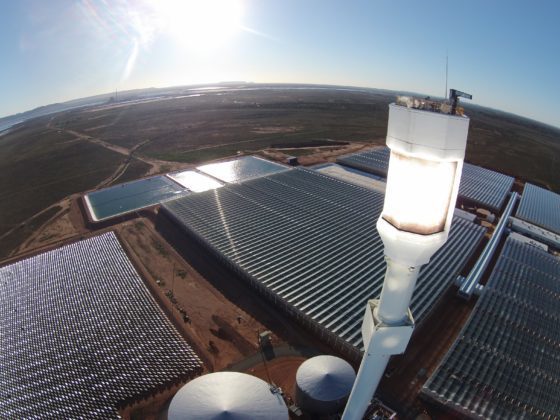Looking at the machinations over the proposed Adani coal mine in Queensland’s Galilee Basin this week, or seeing certain Coalition Senators howling at the moon over wind turbine “emissions”, or the Treasurer brandishing a lump of coal in parliament, it is hard to imagine that any sort of progress has been made in Australia in what all but a determined few accept is the inevitable clean energy transition.

But there is no doubt that the transition is happening. Over the last few months, small but significant gains have been made as key politicians, regulators, market operators and many incumbents realise just how quickly the cost of new competition technologies are falling, and how quick the transition to a smarter, cleaner, more reliable and cheaper grid might be.
Awareness about the plunging costs of wind energy, solar energy and battery storage, along with the enabling software that could lead to a complete redesign of the way we generator, share, transport and use energy, is growing each day.
Politicians – both to the left and the right – are starting to embrace this change. The public is supportive, while the fossil fuel incumbents are slowly and surely losing their social licence, both due to the pollution levels of their plant and their manipulation of prices. Even the regulatory barriers that currently protect their business models are starting to unwind.
This is not to say that victory is at hand, or that this transformation will suddenly be complete within a few years. It won’t. But change is starting to happen quickly, old plant is being replace by new, rules are being changed, industry leaders are starting to talk of a new energy vision. Consumers are picking up new technology with increasing speed.
And here are a bunch of key developments in Australia over the last few months that indicate that the plunging cost of key technologies costs will trump the resistance of conservative ideologues and fossil fuel incumbents.
The new boss at the Australian Energy Market Operator
Audrey Zibelman’s last job was head of New York’s transformative “Reforming the Energy Vision” program. Now she looks set to do the same in Australia. Already she has made an impact, talking of the need to migrate from centralised, fossil fuel generators to a distributed grid dominated by renewables and storage.
She says this will create a grid that is faster, quicker, smarter, cleaner and more reliable than the current model.
Zibelman has engaged with energy ministers, the Finkel review and the industry in her conversations.
This is critically important: The appointment of a person who sees the future and works towards it as head of the Australian Energy Market Operator is transformational. It will change the public and the political discourse, and the incumbents now know they are dealing with someone who genuinely puts consumers first rather than vested interests.
South Australia’s energy plan
The South Australia government finally got sick of what it saw as the mismanagement of the grid by the market operator (pre Zibelman), being held to ransom by the private generators, and by the cheap point scoring of the federal government, so it decided to act.
It streamlined the use of “emergency” powers by the energy minister, announced it would build its own back-up generator, tendered for 100MW/100MWh of battery storage, and flagged a new “energy security target.” For good measure, premier Jay Weatherill shirt fronted federal energy minister Josh Frydenberg at the launch of AGL’s virtual power plant.
The effect has been immediate. It attracted 90 expressions of interest for battery storage, and the EST, which requires retailers to source more than one third of their demand from local “dispatchable” generation and 50 per cent by 2025, is having an impact.
AGL has torn up its plans for the state, and Origin has brough Pelican Point back into full service and written the contracts for a major new solar farm. Others are busily planning storage facilities that will help manage the variability of wind and solar as it soars above the 50 per cent level.
And the beauty of it all? South Australia has added security, has called the bluff of the incumbents, and will probably not have to spend anywhere near the $550 million it has set aside for the task. And it will lower prices.
The billionaire tweets:
 The tweets between billionaires Elon Musk and Australian software entrepreneur Mike Cannon-Brookes didn’t really tell us anything new, but brought the message about the plunging cost of technologies, and the attraction of battery storage, to the front pages.
The tweets between billionaires Elon Musk and Australian software entrepreneur Mike Cannon-Brookes didn’t really tell us anything new, but brought the message about the plunging cost of technologies, and the attraction of battery storage, to the front pages.
It also reached the ears of prime ministers and premiers. All of a sudden, the terms baseload and peak load energy were replaced by a focus on “flexible generation.” The discussion was about what happens when the fossil fuel dinosaurs finally leave the market.
Both South Australia and Victoria attracted around 100 offers each for their respective 100MW battery storage tenders, while Malcolm Turnbull was singing the attractions of a Snowy Hydro 2, and some 2GW of pumped hydro capacity to fill in the gaps between wind and solar.
Falling costs of renewable technologies:
The cost of building large scale wind and solar farms is falling to a fraction of the cost of new coal or gas plants. If you don’t believe us, or the environmental groups, or the investors and local and international developers and analysts who say the same thing, then take the word of someone who should know, Tony Concannon, the former head of Hazelwood brown coal generator.
Concannon now heads Reach Energy, which this week began construction of what could end up being a 300MW solar farm, with storage, near Port Augusta – the biggest solar farm to begin work without a government grant.
Concannon says the cost of large scale solar and storage is already competitive with gas-fired generation, and within a few years the combined cost of solar and storage will be well below $100/MWh.
Think about what that means – it is well below the current price of wholesale electricity, and makes predictions by the likes of ANU’s Andrew Blakers that a 100 per cent renewable energy grid – priced at around $75/MWh – eminently achievable.
Cheap electricity for consumers:
Australia has among the highest electricity prices in the world, thanks to the gold plating of its electricity networks, the manipulation of wholesale prices by the fossil fuel generators, and the huge margins extracted by the retailers. Soon, however, they may soon have the cheapest.
SA Power Networks, which runs the grid in South Australia, says that within five years the combined cost of solar and storage will be just 15c/kWh, or less than half the current cost of grid power.
In W.A. there is no reason why the same costs should not apply, and the new Labor government has flagged that it is looking to remove the huge subsidy that hides the cost of the fossil fuel-dominated grid from consumers. If the subsidy is removed, the cost of power will jump by around one third, making it the most expensive in the country.
Little wonder, then, that both S.A. and Western Australia are adding rooftop solar at record rates, both reaching 17MW in the month of March, as consumers looked to shield themselves from soaring consumer prices and get ready for battery storage. Consumers can see the future. And they can read electricity bills.
 Fossil fuel generator price rorting:
Fossil fuel generator price rorting:
It is now clear that the rising price of wholesale electricity has nothing to do with wind and solar, but has everything to do with the soaring price of gas and the market control by the fossil fuel oligopoly, whose greed and focus on putting profits before people has resulted in a massive own goal.
Indeed, the fossil fuel generators have been rorting the wholesale markets for years, adding billions of dollars to the cost of wholesale electricity. When this shocking state of events has reached mainstream media (which is not often because they seem so focused on wind power), the competition regulator has waived it away as an “exercise of market power.”
The network operators, fearing a backlash from consumers, are now calling them out, and even their great defender, the AEMC, documented in extraordinary detail the cynical manipulation of the markets in South Australia.
The proposed new 5-minute rule will be one of the biggest changes in the market for decades, and the falling cost of battery storage technology should accelerate this change, as will the huge rush of new large scale solar farms and wind farms across the country as gentailers are finally forced to the table to sign contracts with new .
We can expect to see the fossil fuel generators party on for a few years until this new generation comes online, and the 5-minute rule is introduced after a three year transition period. But then, the pillaging pricing party should come to an end.
The transformation of Port Augusta
Much has been and will be written about the challenges facing the Latrobe Valley, and soon the Hunter valley as their massive coal-fired generators close down.
Leading the transformation, though, is the city of Port Augusta in South Australia. Its two brown coal generators, Playford and Northern, have closed in the last few years – and are now being replaced by solar thermal, solar PV and wind energy.
The greenhouses at the Sundrop tomato farm are now heated and powered by a statuesque solar tower, a 300MW solar farm that is “battery ready” has already begun construction, and a contract for a 212MW wind farm was also signed this week.
Many other projects are also looking to begin, none more so than the 110MW Aurora solar tower and molten salt storage facility, which looks to have gained the promise of a $100 million concessional loan from the federal government.
Nothing highlights the clean energy transformation more dramatically than what is happening in that city. Good on the council, and good on the people at Repower Port Augusta for having the vision and drive to help make it happen. And good on the project developers and financiers for delivering.
Note: Please click below to listen to the podcast of our weekly analysis












